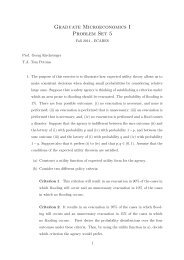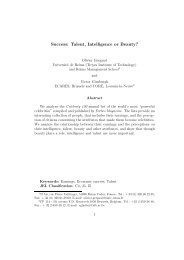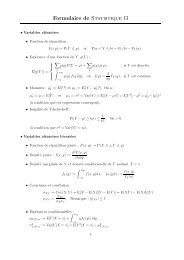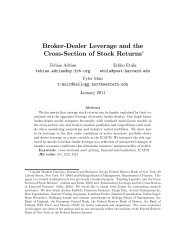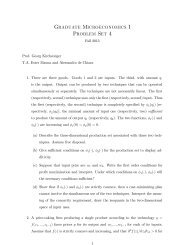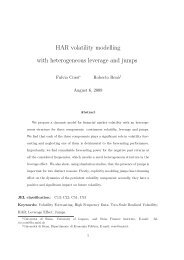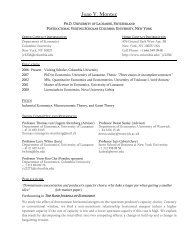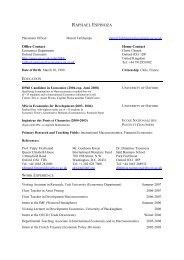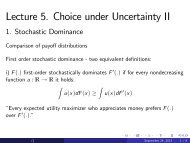may result <strong>in</strong> a decrease <strong>in</strong> overall profit as switch<strong>in</strong>g costs <strong>in</strong>crease. 7 More <strong>in</strong>terest<strong>in</strong>gis that here identifies additional channels which may make overall profit decreases <strong>in</strong>switch<strong>in</strong>g costs. In particular, network externality and naivete make it more likely thatswitch<strong>in</strong>g costs lower first-period equilibrium prices, and hence reduc<strong>in</strong>g overall profits.4 ExtensionsThe analysis so far is based on a s<strong>in</strong>gle-hom<strong>in</strong>g model, but this is not the only marketconfiguration <strong>in</strong> reality. There are various ways to extend the model, for <strong>in</strong>stance, onemay consider the case where one group s<strong>in</strong>gle-homes while the other group may jo<strong>in</strong> eitherone platform or both (commonly termed as “competitive bottlenecks” because eachplatform has exclusive market power over the multi-hom<strong>in</strong>g consumers), the two groupsof consumers bear different switch<strong>in</strong>g costs, and the two platforms are asymmetric. I willsketch these extensions <strong>in</strong> turn, but leave the full-scale analysis of them for a separatestudy.4.1 Competitive BottlenecksSuppose that side A cont<strong>in</strong>ues to s<strong>in</strong>gle-home, while side B may multi-home (or not). 8Competitive bottleneck framework is typical <strong>in</strong>, for <strong>in</strong>stance, the computer operat<strong>in</strong>gsystem market (users use a s<strong>in</strong>gle OS, W<strong>in</strong>dows, Mac or L<strong>in</strong>ux, while eng<strong>in</strong>eers developsoftware for different OS), and onl<strong>in</strong>e air ticket or hotel book<strong>in</strong>gs (consumers use onecomparison site such as skyscanner.com, lastm<strong>in</strong>ute.com or book<strong>in</strong>g.com, but airl<strong>in</strong>esand hotels jo<strong>in</strong> multiple platforms <strong>in</strong> order to ga<strong>in</strong> access to each comparison site’sconsumers). S<strong>in</strong>ce side B can choose both platforms, switch<strong>in</strong>g costs and loyalty onthis side are not relevant (s B , µ B = 0). 9 The ma<strong>in</strong> difference from the s<strong>in</strong>gle-hom<strong>in</strong>gmodel lies <strong>in</strong> the market share of side-B consumers, which can be described as follows.A consumer from this group is <strong>in</strong>different between buy<strong>in</strong>g and not buy<strong>in</strong>g from platform0 ifv B + e B n A 0,2 − x − p B 0,2 = 0,which can be simplified ton B 0,2 = x = v B + e B n A 0,2 − p B 0,2.7 See for <strong>in</strong>stance Klemperer (1987a).8 Side B does not necessarily universally multi-home.9 Note that the concept of multi-hom<strong>in</strong>g is not compatible with switch<strong>in</strong>g costs <strong>in</strong> the current framework.As an example, th<strong>in</strong>k of the smartphone market. If the option to multi-home means consumersare able to use both iPhone and Android systems, then it is not reasonable to impose an additionallearn<strong>in</strong>g cost on them if they switch platform. Another example is the media market. If multi-hom<strong>in</strong>gmeans that advertisers are free to put ads on platform A, B or both, then it does not make sense toimpose a switch<strong>in</strong>g cost on advertisers who buy ads on one platform only. Even if we dist<strong>in</strong>guish betweenlearn<strong>in</strong>g switch<strong>in</strong>g costs (<strong>in</strong>curred only at a switch to a new supplier) and transactional switch<strong>in</strong>g costs(<strong>in</strong>curred at every switch), as <strong>in</strong> Nilssen (1992), switch<strong>in</strong>g cost is still not relevant on the multi-hom<strong>in</strong>gside because transaction costs and learn<strong>in</strong>g costs are equivalent <strong>in</strong> a two-period model, where consumersswitch only once. This also expla<strong>in</strong>s why it is not useful to consider the case where both sides multi-homewith<strong>in</strong> this framework.16
Similarly, a side-B consumer is <strong>in</strong>different between buy<strong>in</strong>g and not buy<strong>in</strong>g from platform1 ifv B + e B (1 − n A 0,2) − (1 − x) − p B 1,2 = 0,which can be reduced ton B 1,2 = 1 − x = v B + e B (1 − n A 0,2) − p B 1,2.We solve the game by backward <strong>in</strong>duction as before. To simplify the exposition, wefocus on the special case where e A = e B = e, µ A = 0, and δ A = δ B = δ F = δ. Considerthe symmetric equilibrium. We f<strong>in</strong>d the follow<strong>in</strong>g first-period equilibrium prices:p A 0,1 =1 + δs A3 − e2 − v B2 − 2δs2 A (3e2 − 2)3(1 − e 2 ,)p B 0,1 = v B2 .Differentiat<strong>in</strong>g p A 0,1 with respect to s A, we obta<strong>in</strong>Proposition 7. In the two-period two-<strong>sided</strong> multi-hom<strong>in</strong>g duopoly model, where oneside of the consumers multi-homes, while the other side s<strong>in</strong>gle-homes, each side exertsthe same external benefit on the other side, all consumers’ preferences are <strong>in</strong>dependentover time, and they are equally patient as the platforms,i. For the group of consumers who bear switch<strong>in</strong>g costs,• If network externality is sufficiently weak, then the first-period equilibriumprice paid by them always <strong>in</strong>creases <strong>in</strong> switch<strong>in</strong>g costs.• If network externality is sufficiently strong, then the relationship between thefirst-period equilibrium price paid by them and switch<strong>in</strong>g costs is <strong>in</strong>verted U-shaped.ii. If the market is fully covered, then prices tend to be higher on the side that multihomes,and lower on the side that s<strong>in</strong>gle-homes.See Appendix E for the proof.(i) implies that strong externality makes it more likely that first-period equilibriumprices decrease <strong>in</strong> switch<strong>in</strong>g costs, which is consistent with Proposition 5. However,(ii) is different from the s<strong>in</strong>gle-hom<strong>in</strong>g model. S<strong>in</strong>ce side B multi-homes, there is nocompetition between the two platforms to attract this group. The high prices faced bythe multi-hom<strong>in</strong>g side is a consequence of each platform hav<strong>in</strong>g monopoly power overthis side, and the large revenues are used <strong>in</strong> the form of lower prices to conv<strong>in</strong>ce thes<strong>in</strong>gle-hom<strong>in</strong>g side to jo<strong>in</strong> the platform.Before, <strong>in</strong> the s<strong>in</strong>gle-hom<strong>in</strong>g model welfare analysis is not mean<strong>in</strong>gful: welfare isalways the same because all consumers buy one unit of good, the size of the two groupsis fixed, and the whole market is served. It ignores the possible demand-expansion and17



